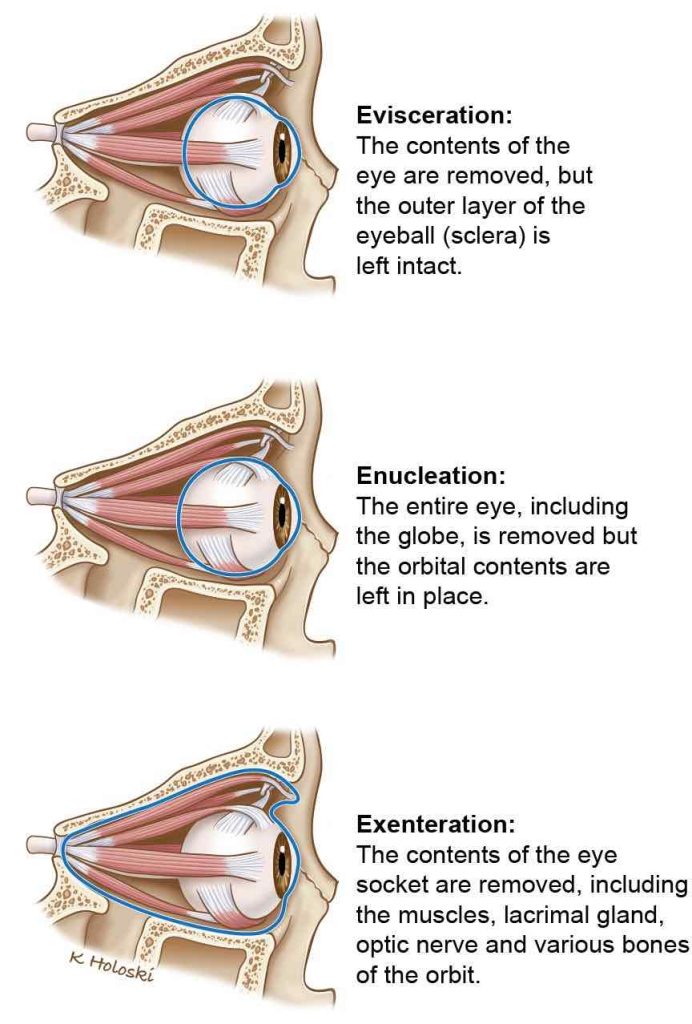Eye Removal Surgery
There are several reasons why an eye would need to be removed. One of the most common reasons is to alleviate a painful eye that is blind due to diabetes, chronic retinal detachment, trauma, or other conditions. Growth of a tumor in the eye, non-remitting infection, or certain injuries can also necessitate more urgent eye removal. The experienced surgeons at SightMD will look into every possible solution to save your eyesight, but if your situation turns out to be more serious, we offer advanced surgical procedures for removal of all or part of the eye. Our compassionate approach to eye care, state-of-the-art surgical techniques, and outstanding post-operative care help make your experience as simple and comfortable as possible.
Surgical Options
Your doctor will walk you through the details of your personalized care plan and answer any questions you have. Depending on your unique situation, your surgeon may recommend one of the following procedures:
Enucleation
Enucleation is the surgical procedure by which the entire eye is removed, including the sclera. The muscles that control eye movement are left behind and intact and are attached to the spherical implant or to the remaining eye socket tissues to increase motility of the residual eye socket contents.
Evisceration
Evisceration is the surgical removal of the cornea and internal contents of the eye leaving the sclera (white of the eye) behind. This removes all sensory components to alleviate blind eye conditions due to benign causes. A spherical implant is inserted in the remaining socket to replace the volume of what was removed. The outcome from this procedure leaves more of the body’s natural volume in the eye socket behind, necessitating less bulk from the implant fashioned by our ocularist. It also leaves the muscles that move the remnant socket attached at their natural positions, allowing more motility of the remaining eye socket structures. There are certain contraindications to proceeding in this fashion, so your surgeon will discuss if you are a candidate.
Exenteration
Exenteration is an extremely rare procedure that is used to remove very aggressive tumors that may have developed in or around your eye. In addition to removing the eye itself, your doctor will also remove the eyelid and the tissues within the socket to completely eliminate all cancerous cells.

Who is a Candidate?
Removal of the eye can relieve pain and minimize further risk to life and well-being of an individual with the following conditions:
- Extensive trauma to the eyeball
- Severe pain in a blind eye
- Malignant tumors
- Infection that is unresponsive to antibiotics
- Prevention or treatment of sympathetic ophthalmia (a serious autoimmune condition following trauma)
- Congenital lack of an eye or small eye (to enhance the development of the bony orbit)
- Cosmetic improvement in disfigured eyes that don’t see
- Orbital tumors (tumors in the tissues behind the eyes)
Are There Any Risks with Eye Removal Surgery?
The decision to remove an eye can be one of life’s most difficult decisions. While evisceration or enucleation is performed to save a person’s life, to relieve pain, or treat disease, it is not without risks. Your surgeon will discuss with you in detail the risks involved, but some of them can include:
- Infection
- Bleeding
- Difficulty closing your eye
- The implant falling out
- Need for additional surgeries
Preparing for Eye Removal Surgery
Your preoperative consultation is important to create a plan for the eye removal surgery and determine what other medical issues need to be addressed prior to the procedure. This ensures that the surgery and anesthesia will be safe to perform.
When picking a date for your surgery, please keep in mind that you will need to avoid heavy lifting, strenuous activities, and dirty environments for at least two weeks after the surgery. You will not be able to swim for three weeks. Additionally, you will need to heal for at least 2 months before you are eligible for prosthesis fitting. Please schedule your surgery accordingly, especially if you have any upcoming events such as weddings, graduations, vacations, or work or social events.
This surgery is an outpatient surgery, which means you will go home after the surgery and will not spend the night at the hospital. You will need a driver that is 18 years or older to take you home and take care of you the night after surgery because it is not safe to drive right after the anesthesia you will be given during the procedure.
What to Expect Day of Surgery
Eye removal surgery requires you to receive anesthesia and depending on your other medical conditions, there are two types of sedation we may use. If you are put under general anesthesia, you will be completely asleep and need a breathing tube, this type of anesthesia also requires a longer recovery time. If you elect for monitored anesthesia care, you will not be put completely to sleep – it is called twilight sedation. You will be given relaxing medication through an IV, similar to a colonoscopy, and you should feel comfortable the whole time; some patients even sleep throughout their entire procedure while breathing on their own. For both types of anesthesia, you will have the entire area around the eye numbed for your comfort throughout the surgery. You will be awake and ready to go home shortly after the surgery.
At the end of the procedure, you will have a large pressure patch placed over the eye and it may be slightly uncomfortable or irritating because it will be fairly tight and may feel itchy. However, this patch is very important to keep swelling and bruising down and you should not remove the patch unless instructed otherwise. We will remove it for you at the one-week follow-up visit. You will not need to use any prescribed ointment until we take the patch off for you in the clinic. It is important that you do not get the patch wet or it will fall off.
Most patients have mild discomfort after surgery, which comes mainly from two things:
- The patch will be applying gentle pressure to a tender area.
- Because both of your eyes move together, when the seeing eye moves, the muscles in your enucleated eye will move as well. After surgery, the tissues and muscles around the eye are inflamed and will feel sore when they move. This is very similar to how your muscles feel sore the day after exerting yourself at the gym.
While we do send you home with some narcotic medication, most patients do well with just acetaminophen (Tylenol) andTake the pain medication as prescribed only if it is necessary.
What to Expect After Eye Removal Surgery
After eye removal surgery there will likely be swelling, bruising, and mild discomfort. A pinkish or watery discharge may also occur, and the socket may have a scratchy feeling. These aftereffects are normal and should go away in a few days.
Your surgeon may prescribe medications to prevent infection or otherwise aid in recovery. A bandage will be placed over the treated eye for up to one week. It is important to keep this bandage on as long as directed and to keep it dry. Take care not to bump, press, or rub your eye socket. There will be a follow-up appointment with your surgeon within the first week to evaluate how you are healing.
Your surgeon will have recommendations for you regarding specific restrictions, but standard restrictions include no lifting, bending at the waist, pushing, pulling, or other strenuous physical activity for the first one to four weeks after surgery.
For most patients, the healing process will take six to eight weeks, at which point you can be fitted for a prosthetic.
SightMD uses the most sophisticated surgical techniques available to ensure the best possible outcome. Whatever your situation, and regardless of its seriousness, we will see that every stage of the procedure – before, during, and post-operative – is handled with the greatest skill and care to keep you safe and secure. Following your treatment, we also offer the option of cosmetic surgery to restore your appearance, which will in turn boost your self-confidence.
Common Questions to Ask your Doctor
Here are some important questions that you should go over with your doctor before your procedure.
Why is enucleation or evisceration necessary?
Removal of an eye may be required following a severe injury, to remove an intra-ocular tumor (tumors inside the eye), to control pain in a blind eye, to alleviate a severe infection inside the eye, or for cosmetic improvement of a disfigured eye.
Are there any alternative treatments available?
There may be other treatments available and your doctor will have discussed these with you. If you feel that you need further information, please ask your doctor.
What will happen if I choose not to have surgery?
There can be a number of different outcomes if you choose not to have your eye removed. An intraocular tumor may continue to grow or spread to other parts of the body making treatment more difficult. An infected eye may become worse and the infection may spread making treatment and pain management more difficult.
Why choose one procedure over another?
Enucleation is generally the procedure used if the eye is being removed to treat an intraocular tumor, severe infection, or to reduce the risk of developing a severe autoimmune condition (called sympathetic ophthalmia) following trauma to the eye.
Evisceration is a less invasive procedure and may be an option depending on the condition of the eye to be operated on. Your surgeon will advise which surgery is most appropriate for you.
Contact SightMD today to schedule an appointment with one of our doctors to discuss your Ophthalmic Plastic Surgery options at one of our convenient locations!

6 Tips for Selecting the Perfect Hearing Aid
Hearing aids are not just devices; they are gateways to a clearer world of sound. With the right hearing…

Recognizing the Signs of Hearing Loss in Children
Understanding Hearing Loss in Children Hearing loss in children can be classified as either congenital (present at birth) or…

Signs of Potential Vision Problems in Kids
Recognizing the Signs of Potential Vision Problems in Kids Good vision is essential for children’s overall development, academic performance,…